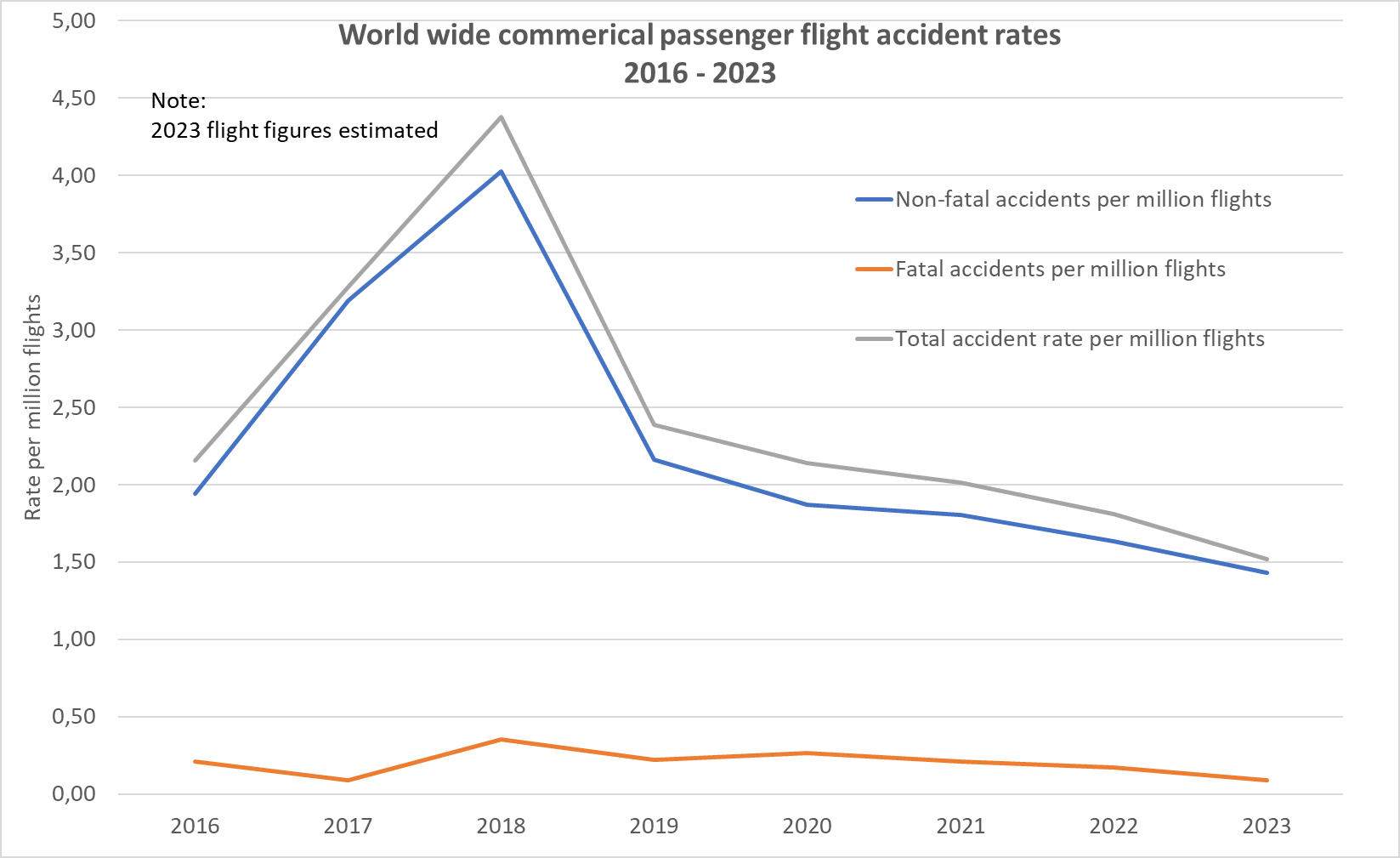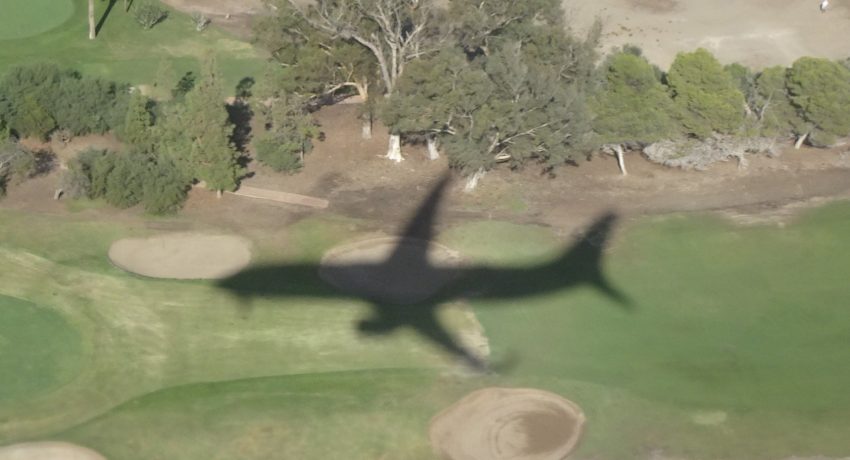As the new year dawns and we look back across 2023, civil aviation finds itself in a similar position to 2017 with no fatal accidents to large turbofan powered, passenger aeroplanes in commercial service. Indeed, the number of fatal accidents to large passenger aeroplanes in commercial service is only two. This excludes one accident where a ground handler was killed on being ingested into an aircraft’s engine. There have been a number of incidents and non-fatal accidents that require the industry to remain vigilant. Serious injuries due to turbulence remain an ever-present factor in the year’s accidents.
Some of the staffing issues at airports that were seen immediately post-COVID have been resolved. Regardless of how low the accident rate in 2023 has been, there is no cause for complacency. Aviation remains a risk-laden industry and as airports around the world report that movements are reaching the same level as in 2019, before the COVID-19 crisis, a number of issues have not gone away.
Of concern to accident investigators is the attitude of the Russian authorities in response to the accident to the Embraer EMB-135 carrying the head of the Wagner Group, Yevgeny Prigozhin. International law [1] requires States to involve the States of manufacture, among others, in investigations. The exclusion of the Brazilian authorities and Embraer by the Russian Interstate Aviation Committee (IAC) is an unwelcome step that goes against the collaborative nature of accident investigation and does not help with the main reason to investigate accidents; the learning of lessons.
As we mentioned in 2022 the focus on sustainable aviation (new fuels etc.) and concepts such as urban air mobility requires vigilance to ensure that developments in this field do not have an impact on safety. We must ensure that we do not introduce new risks to civil aviation.
A lower than average fatal accident rate
As ever, the To70 civil aviation safety review examines accidents only to larger passenger aircraft used by most travellers. (See our criteria in the Note below.) We include all causes, whether technical failure, human error or unlawful interference. In 2023 there were 50 accidents, 2 of which were fatal, resulting in 86 fatalities [2]. Both the number of accidents and fatalities are at a record low. In 2022 there were 33 accidents, 6 of which were fatal, resulting in 178 fatalities. The fatal accident rate for large aeroplane accidents in commercial air transport (including the death of the ground handler) is 0.09 fatal accidents per million flights, compared with 0.10 per million in 2022. This is a rate of less than one fatal accident every fifteen million flights and it is significantly lower than the ten-year average of 0.20 fatal accidents per million flights that we note from the data.
There were no fatal accidents [3] to large turbo-fan powered passenger aircraft in 2023. Looking at the two fatal turbo-prop accidents, the following is noted:
|
Date (2023) |
Type |
Operator |
State of registration |
State of occurrence |
Fatalities |
|
15 JAN |
ATR-72 |
Yeti Airlines |
Nepal |
Nepal |
72 |
|
16 SEP |
Embraer 110 |
Manaus Airlines |
Brazil |
Brazil |
14 |
The accident report into the Yeti Airlines was published just before the year’s end. The inadvertent movement of both condition levers to the feathered position in flight, resulting in the feathering of both propellers and subsequent loss of thrust, leading to an aerodynamic stall during the approach was stated as being the cause of the accident. A number of human factor issues were identified as contributing to the accident.
Increasing our focus on the mental well-being of crew members
From the fatal accidents in 2023, there are too few fatal accidents to determine detailed trends. Looking at incidents and non-fatal accidents, we see a disturbing number of runway incursions around the world with the aircraft entering the runway when it is occupied or another aircraft is close to landing on that landing. Whilst at first glance it may be seen as alarming, it is good to see that more and more attention is being given to mental health of crew members. Some see this attention as the result of increased numbers of incidents but, for too long, crew members were expected to bottle up problems and ‘get on with it’. Increased attention and the introduction of programmes to support those struggling with mental health issues is only to be welcomed.

Methodology
To70 uses official figures reported by States to the UN’s aviation agency, ICAO, to determine the number of civil aviation flights that have taken place in any given year. The actual figures, published by the air transport organization, IATA, are used to estimate the current year’s figures. We update our database each year when the actual flight numbers data for the previous year becomes available.
Accident data is derived from publicly-available databases, aviation authority websites and official sources such as ICAO’s ADREP database. Our analysis documents accidents to passenger flights commercial air transport operations in aeroplanes with a maximum take-off mass of 5700 kg or above. This excludes a number of small commuter aeroplanes in service around the world, including the Cessna Caravan (maximum take-off mass 3629 kg). Certain relevant exceptions may be included regarding smaller turbo-prop aeroplanes just below this mass limit (e.g., the De Havilland Twin Otter with a maximum take-off mass of 5670 kg). Accidents to military flights, training flights, private flights, cargo operations and helicopters are excluded. Unlike statistics produced by IATA and ICAO, accidents involving unlawful interference are included in our analysis.
As the vast majority of commercial air transport operations take place with large aeroplanes, the effect of the excluded types on the accident rate is very small.
[1] See article 26 and Annex 13 of the Convention on International Civil Aviation (Chicago Convention).
[2] This excludes the death of a ground handler; 23 June 2023 at San Antonio, Texas
[3] See note 2

Senior aviation consultant, who has worked in aviation safety for over 30 years, both for governmental and industry organisations. He is a qualified aviation accident investigator and holds an advanced master’s degree in air & space law. He has performed accident and incident investigations for the Dutch accident investigation body, Dutch Safety Board. The establishment and management of aviation Safety Management Systems and the provision of staff training in their SMS-related activities has been a part of his work since 2008. In addition to safety management work, he works regularly on projects related to aerodrome & heliport design (including OLS) and the effect of airspace regulations on access to airports & heliports.


Dear Mr. Young,
Many thanks for this article, which brings us positive tidings. It is particularly very good to read that there is a growing attention for mental health of crew members. On the other hand it is a great pity to see only crew members mentioned here. We, at AviAssist strongly believe in the necessity of mental health with every single aviation professional, no matter what their operational role in the industry is. We also wonder by whom this attention for mental health is given and to whom. The article doen’t clarify this unfortunately. Please continue your good work with to70. Kind regards,
Rien Doorn
Senior Program Manager
AviAssist Foundation
Safety resources for the African aviation industry since 1995